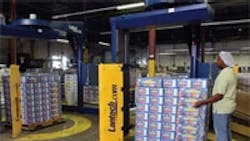Stretch Wrapping Ices Six-Month Payback
Can one stretch wrapping machine be safer than comparable equipment, while still being less expensive, miserly with materials, smaller and more convenient to use? Kisko Products (Markham, Ontario), maker of some of North America’s favorite frozen treats, found the answer is “yes” when it applies to the company’s two stretch wrapping machines added to its packaging line. Safety was an overriding decision factor; however, the six-month payback in reduced film use and overtime made the two S-300 rotary-arm machines from Lantech (Louisville, Ky.) an accountant’s dream, according to Randy Josephs, vice president of operations at Kisko. The two new machines have reduced film use more than 35%, and eliminated about four hours of overtime a day, while churning out several hundred pallets per day during the company’s seasonal peak.
Sweet Success
Kisko Products produces and distributes freeze pops and premium juice products. Founded in 1977 and owned by the same Canadian family, Kisko Products employs about 115 people and will soon move to a new facility to support its growth.
Kisko Freezies consist of liquid juice in a clear tube that’s produced on a form/ fill/seal machine. It mixes all ingredients on site in concentrations up to 100%, using orange, mango, black cherry, grape, apple or pear juice, among others. The sealed liquid tubes—ultimately frozen by the consumer—are packed in a box for point of sale, and then cased.
“Much like our plant equipment, we put a premium on safety as it relates to our transport packaging,” says Josephs. Cases are hand palletized in loads up to 40 inches wide by 48 inches long by 70 inches maximum height, or in half-height loads. The company’s aging turntable stretch wrappers were slow and inefficient in the pre-stretch of film, so ongoing material costs were high. “We knew that new equipment on the market could cut our film use significantly and improve our overall efficiency,” explained Josephs, “so we started to look at our options.” Because the loads weigh up to 1,800 pounds and are relatively top heavy and unstable, Kisko focused on rotaryarm stretch wrappers to replace the turntable machines.
“At the time we started to look at new equipment, all the machines on the market with rotary arms required a safety fence around them, including Lantech’s,” explains Josephs. “Apart from the added cost and floor space needed for the fence, it’s never a perfect solution because someone will always find a way to defeat a safety perimeter while the machine is running or being serviced.
“Even after an E-stop, the arms on most stretch wrapping machines will continue to rotate for one-half of a revolution or more, and you don’t want to be the person whose sleeve or pant leg just got snagged on that arm. We also use manually applied corner boards to our loads, which would complicate the operation of a fenced-in machine or require additional automation.”
Then, Lantech introduced the S series straddle stretch wrapping systems with a large shock-absorbing safety shield on the arm and a drive system that stops the rotation immediately if there is any pressure on the safety shield. “These machines proved as safe or safer than those with a perimeter fence; they cost less because there’s less hardware, and they take less floor space,” says Josephs. “We had budgeted for one fenced-in machine, but for just a little more money we could
afford two of the unfenced S-300 machines. This gave us needed redundancy and extra capacity for growth, because just one of these machines has greater output than our two older machines combined.”
The S-300 is a freestanding stretch wrapping system that requires no wall mounting and takes up just 188 square feet. It can wrap 25-35 loads per hour up to 76 inches high, with operator intervention limited only to attaching the film to the load. Automatic film cut-off lets the operator hop back on the lift truck after starting the wrap. Film savings is accomplished with electronically controlled pre-stretch, which is normally 200%, however can range from 100 to 300%. Kisko’s machines are set for 200% pre-stretch with 70-gage film, and each pallet is wrapped in two layers of film.
The machine provides a 14-inchwide clearance between the moving wrap arm and the machine’s single vertical column to protect any worker who might get between the column and the arm. “The safety system on the S-300 amazed even the inspector from Canada’s Ministry of Labor,” says Joseph. “He initially said this machine needed to be fenced in. The arm turns as fast as any fenced machine, but stops dead in its tracks if the bumper strikes anything in its path.”
Kisko paired the new wrapping machines side by side, providing three points of entry for lift trucks and walkies: one from each side and one into the front of either machine. “This arrangement of the machines facilitates double stacking small pallets, which some customers require,” he says. “We drop two half-height loads in front of each machine, wrap them, then pull one and stack it atop the other to complete the load with another wrap cycle.”
The micro-controller on the S-300 allows programming of different speeds for rotations in any part of the cycle, which facilitates Kisko’s manual placement of corner boards to add support and help maintain the exterior appearance of Kisko’s packaging during shipping. “We program the first two rotations at a slow speed to allow the operator to place the corner boards, then the arm finishes the cycle at normal speed,” says Josephs. “With slippery cases and top-heavy loads weighing as much as 1,800 pounds, corner boards give our products and anyone handling the pallets, an extra measure of protection we believe is worth the cost.”
For accounting and budgeting purposes, he says, they projected an 18-month payback for the first two machines. “But we could see a huge difference in costs in just six weeks, and actually paid for the machines in six months.”
